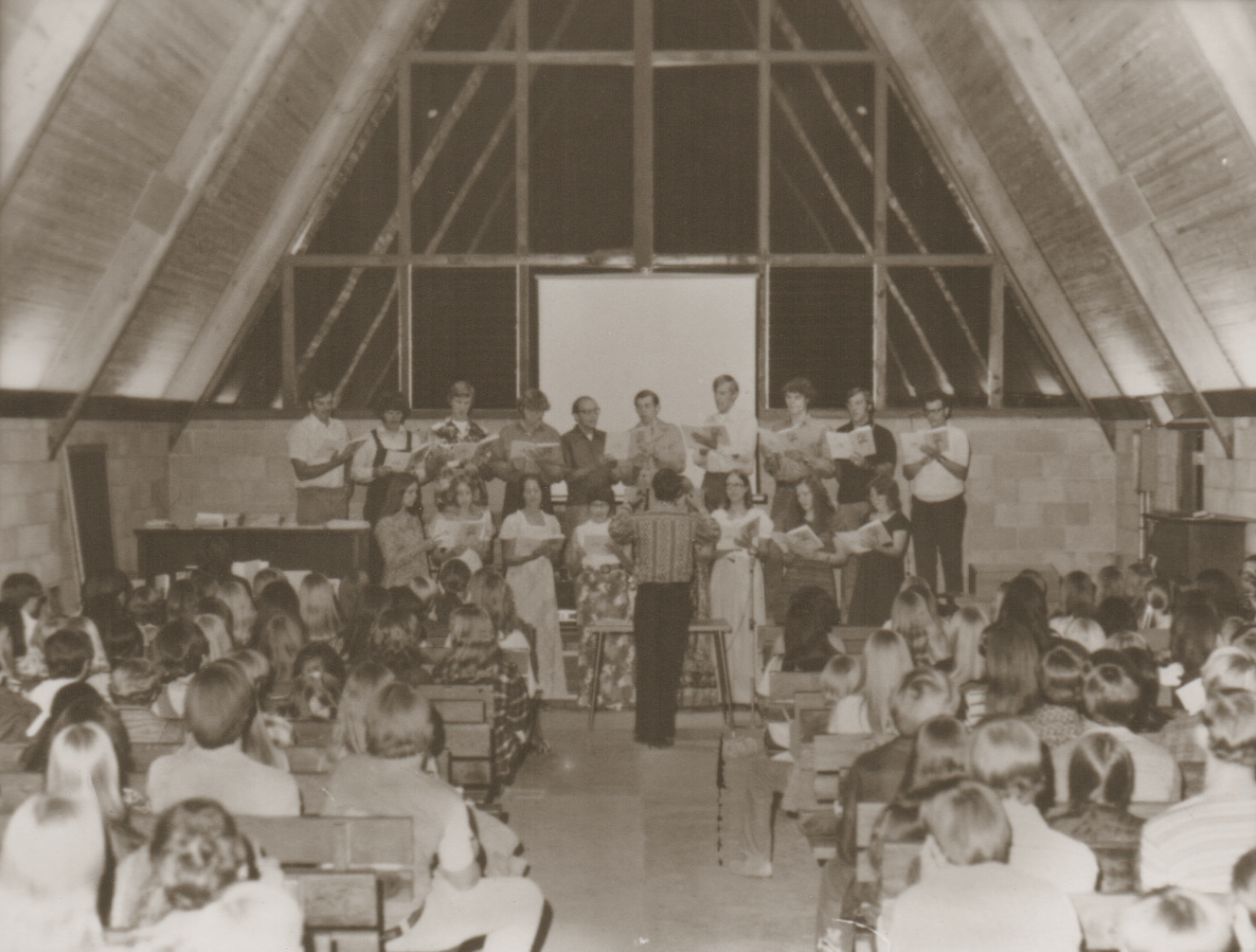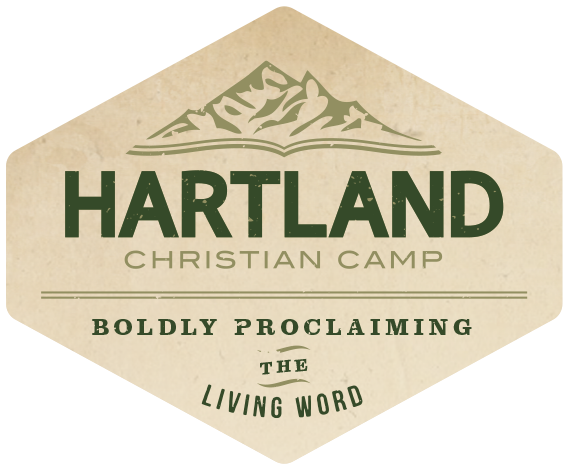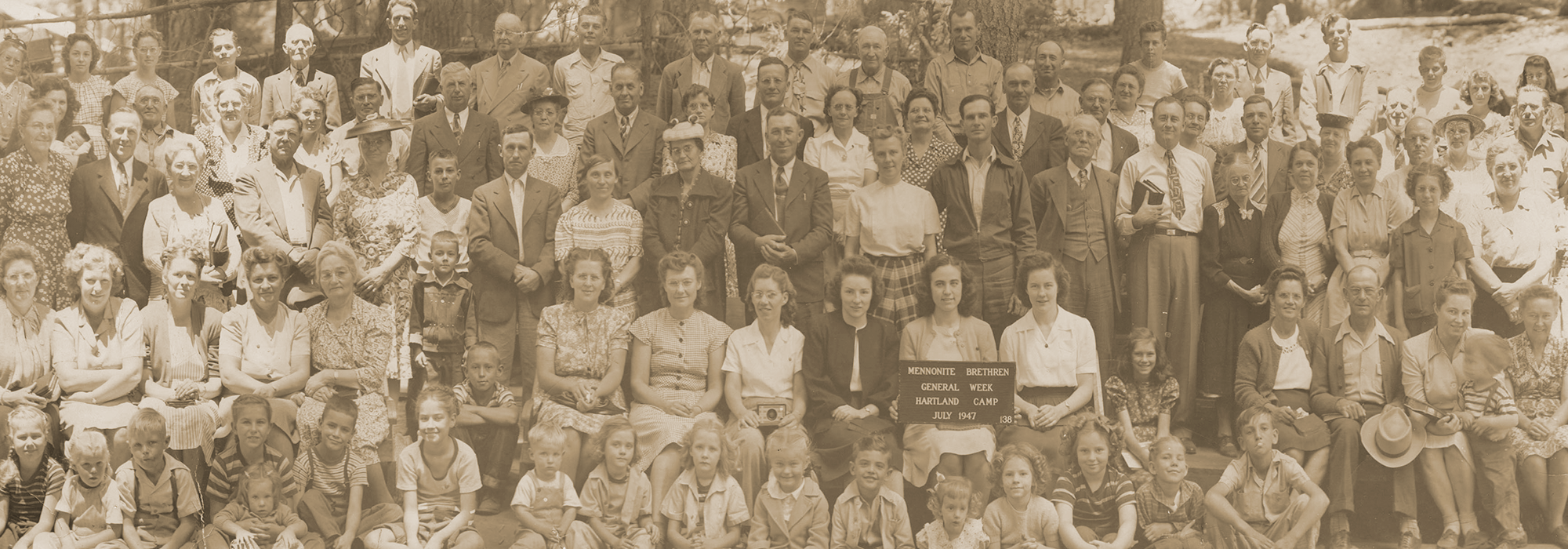History

INTRODUCTION
As the early years of the 1940s began to unfold, God seemed to whisper into the heart of William Weibe, the Youth Advisor of the Reedley Mennonite Brethren Church, the idea of starting a Christian Camp for the youth of the Central Valley. The camp’s purpose would be to lead young people into a closer, more intimate relationship with God and to bring many to the knowledge of Christ as their Savior.
William shared his vision of a Christian Camp with Rev. G.B. Heubert of the Reedley M.B. Church, Rev. J.P. Siemens of the Dinuba M.B. Church, and Rev. J.J. Kliensasser of the Zion Church. These Pastors enthusiastically supported the idea, and the vision began to grow. William began meeting regularly for prayer and planning with John Braun, Abe Leppke, Pete Driedger, and Jack Gunther, and the vision grew.
In the summer of 1942, the first camp took place at Sequoia Lake, followed by very successful camps in the summers of 1943, 1944, and 1945. On October 16, 1945, the decision was made to purchase a plot of 80 acres at Hartland; the deal was closed shortly thereafter. A dedication service was held in early June of 1946, and the first summer camp took place that same summer. Souls were saved, and others were drawn closer to God. William’s vision had been fulfilled, but God’s vision had just begun, and it would serve as a vessel for His glory for countless generations to come.
Those early years of camp were anything but comfortable. Ice was transported from the valley to keep food cold, meals were cooked over wood stoves, there was no electricity, so lanterns provided the only light, and campers rode up from the valley on rough dirt roads in the back of flatbed trucks. But there was a sense of excitement in the air as lives were being changed each week at camp. Volunteers gave their time and energy, and donations poured in to build the camp and meet the needs of campers.
The gospel message was and is the central focus of Hartland Christian camp. That message of hope was proclaimed from a dirt stage to campers on homemade benches, or no benches at all, and the result was miraculous. Campers repented of their sins, and Jesus Christ saved their souls.
This historical record has been compiled at the request of the Hartland Board in an attempt to, as accurately as possible, record the events of the early days of our experience at Hartland. Some of these experiences are a matter of record in the Office of Records of Tulare County, Visalia, CA.
Other items are from records of our own involving sales and purchases where title company or attorney assistance was used. In addition, the carefully evaluated memories of Hartland members and others who had direct participation in each of the early events became the basis of our records.
ORIGIN
Mountain retreats for young people have had the attention of religious leaders for many years. Intensive Bible study periods, character building, and leadership training have been instituted by church groups and religious organizations, and many of them have been carried out quite successfully.
For the summer of 1945, a committee dealing with this matter made arrangements with park officials to hold camp meetings at General Grant Park. As a result, what was initially planned to be a 4-week program was extended into a 7-week, well-attended one. This fact accelerated the effort to establish a permanent camp of our own.
On October 14, 1943, a few individuals met to consider primary steps toward the establishment of retreat grounds. At this meeting, the “Millwood Christian Association” was formed, named after the property located at Millwood, which was being considered on a lease basis at that time. This location did not have all the desired features of a retreat camp, so further investigations of other available sites were made.
On October 16, 1945, a decision was made to purchase a plot of 80 acres at Hartland, and the deal was closed shortly thereafter. This led to the change in the organization’s name from “Millwood” to the “Hartland Christian Association.” At this time, the membership had grown from the original five to about 12 members, and additional members joined the group shortly after purchasing the property.
To safeguard the camp against interference by undesirable establishments in the near vicinity of the camp, the Association also decided to purchase the 80 acres adjoining our property on the north. This would also give the camp additional areas for future development.
Early in May 1946, all members who could spare the time, and many others who joined in the spirit of the camp, commenced intensive work to clear the area and erect the necessary buildings and other structures to conduct the summer retreat. This work was soon completed, and early in June 1946, appropriate dedicatory services were held at the location.
LOCATION OF THE CAMP
The property is located in Tulare County, approximately 10 miles east of Badger. At that time, the last four miles were not paved. The camp is easily accessible and, at the same time, sufficiently isolated to create a peaceful mountain environment. It contains many desirable features, such as large groves of timber, sufficient open spaces for recreational activities, and an excellent climate.
The elevation is about 4,500 feet, and the temperature will average about 20 degrees lower than the valley’s.
Much beauty is added to the camp by the stream, known as Eshom Creek, which runs the entire property length and directly through the campground area. A concrete dam was built to replace the former wooden structure, creating a lake of sufficient size to permit boating and fishing. It is an area that, by its environmental features, has always promoted good timber growth. Some very large cedar stumps still remain from the turn of the century logging operations.
PURPOSE
Hartland is committed to boldly proclaiming the Living Word. The goal being to produce Christians committed to knowing, living, and sharing a compelling faith.
MISSION
This will be accomplished through innovative, relevant, high-quality camping experiences for all ages. The goal being to serve groups who are in agreement with Hartland’s belief and purpose or where there is, at minimum, an opportunity for pre-evangelism through contact with our staff and/or use of our facilities.
Additionally, Hartland carries out normal weekly services on Thursdays for the staff and surrounding community. In the summer, there’s an additional Saturday evening service – ask the office for more details if you’d like to attend our Chapel services.
FIRST LAND PURCHASE
The first 80-acre parcel was purchased in October of 1945 for the price of $3,000.00. One of our members knew a Mr. Dungeon of Exeter, California, who owned this parcel. A committee was appointed to look at the property, and a decision was made that this would be an excellent site to start a camp. Shortly after that, the 80 acres to the north was purchased for the price of $8,500. Articles of Incorporation were completed in August 1946.
The lower 80 acres were selected to be the site of our first effort to build a camp. We needed a lot of lumber, and we had the trees. The owners of the Wortman Saw Mill, located near Farmersville, were contacted, and they selected several prime fir trees, hauled the logs to their mill, and cut them into lumber.
Then, after a brief time to “cure” this freshly cut lumber, our members who had trucks hauled this rough-cut lumber to the campsite.
Time was very short, and to prepare the camp for our first camping season, the call for help went out to all who could put in the time. At first, the response was rather slim, but in a short time, we had a sizeable crew at work. Many came up for a day at a time, but some chose to stay nights, using the cabin on the east side of the creek. This cabin had a wood-burning cookstove where we could prepare meals and sleeping accommodations for 8 to 10 people—these evenings also provided a lot of good fellowship and relating of experiences, including some good fish stories.

DINING HALL
The first structure to be built was the dining hall. From the mill, we got no heavy timbers, only dimension lumber, 2 “x 4”, 2 “x 6”, 1 “x 6”, and 1 “x 12”. We cut trees from the area to be used for the girls’ campsite. We peeled the bark from these trees, put them down somewhat in the ground, and then put the floor of 1 “x 12” on these logs. The sides were closed with appropriate openings for doors and ventilation. A fairly substantial roof of 1 “x 6” and some 2 “x 4” material for rafters was built, and then we put a large canvas cover over all. This canvas was donated for summer use by one of our members. It served during the winter as a haystack cover on the dairy farm of this member.
The first dining hall was about 30’x60’ in size, and the north end was used for a kitchen. Wood-burning cookstoves, dishes, and silverware, etc., came from donations. Iceboxes were also provided, and large pieces of ice were brought in as needed. Lamps and lanterns provided light after darkness.
Tables made of rough lumber with an attached seating arrangement were built. This was later changed because if too many people sat down on one side before the other side was occupied, the whole table fell to the loaded side.
The improvements to the dining hall also continued on a progressive basis. After a year or two of canvas covering, the framework went up for a large dining area and kitchen on the original concrete foundation and floor. Also, by this time, we were adding all the conveniences we could, including inside restrooms, electric lights, and refrigeration. From this point, we continued to grow.

WATER
We had purchased a “Little Red Engine Pumper” with a considerable length of hose to be used for fire control. However, it ended up mainly in use for the domestic water supply. It could also be disconnected and carried about to other locations when needed. It would lose its prime at the most inordinate times due to sand or other debris getting into the pump. We soon became experts in quickly correcting this situation. A kit of tools was always available.
Cold showers were located near the north end of the dining hall, with a privy nearby. This was for the convenience of the kitchen staff.
The first dining area was located where the patio area is in front of our current dining hall. The site was fairly level, but a lot of hand shoveling had to be done to make a suitable area for the floor. We did not even possess a wheelbarrow at that time. The roof structure usually did not survive the winter snow and wind storms and would come down. Then we put it up again and covered it with the canvas.
POWER AND PHONE
One small but essential building we called the “Klink.” How it got that name is not clear. It was built to store shovels, rakes, small tools, nails, and other hardware. It was also our first powerhouse after a gasoline engine generator was secured. This little unit was an Army surplus item formerly used in the B-24 Bombers. It was a 24-volt unit and would light some 10-12 bulbs. It was fairly dependable but very noisy. No one would sleep while that staccato roar was going on. We tried to muffle the sound, but it blew the mufflers right off the building. We later bought another quieter generator from a school district in the area, which gave us some more light but more trouble to keep it going.
As building programs developed, the need for both water and power increased. Larger generators were available, and we took one that Reedley College had.
We had a lot of trouble with this one, so we found another practically new one with a self-starter. It gave us both 110 and 220-volt energy to get lights to the new buildings. We were also negotiating with General Telephone Company for telephone service to the camp. Their lines had reached the Badger area by now, and we agreed with them to supply and set the poles to that area. Our MCC crew cut suitable young cedar trees, stripped the bark, and treated the base of the poles with a Penta solution. Then, again, after a time to cure these green poles, the crew set them in place, going over the mountain, down through Hyde Ranch, and joining with the Badger connection. Soon after that, in the spring of 1961, we had telephone service. PG&E soon followed the same route with its service to Hartland.
TRANSPORTATION
Transportation of young people to this camp was mainly by trucks, mostly furnished by Hartland members. The roads were generally paved up to Eshom Valley, but beyond that point, they were very poor; what roads were there were left by some old-time logging operations and by the residents of the Hartland subdivision. There is no record of how they were maintained or by whom.
The county did not provide snow clearance on the roads at that time, so our own rather meager equipment had to do the job. An old Model ‘A’ John Deere tractor, loaned to the Association, was conveniently stationed at the bottom of the “hill” to help get cars or pick-ups to the camp area.

FIRST LAKE
As to the dam itself, the term “weird” would better describe the structure. It has always been a dual-purpose structure, also serving as a bridge connecting the two sides of the camp area. Floods have severely damaged it on two occasions. One of these floods went around the east side and not only washed out that side of the weir but also the cabin, which contained some furniture and several pianos. Several large trees on the east side of Eshom Creek fell to the west and landed on top of the Coffee Shop. One of these trees landed on top of an adjoining cabin and badly damaged it.
With the completion of the weir, we were able to impound some two acre-feet of water into a sizeable lake. This lake was primarily for boating, as well as an excellent facility for fishing. Eshom Creek was always a good creek for fishing as it provided a natural environment for the reproduction of trout. However, fishing was greatly expanded by planting catchable-sized trout, and an important program feature was introduced: The Father and Son Fisherman Conference.
FIRST POOL
A large swimming pool was in order. The site selected was near the lake and roadside, a center for activity, and close supervision. The original heater for the pool was an old wood burner, probably from an old steam heating system.
It was soon replaced by a newer unit, using Butane and with a better control system for safety reasons.

FIRST CHAPEL
In 1961, the Chapel was built. The facility that we originally called the “Chapel” was laid out on the hillside near the boys’ camp area. It was all wood floors and a platform with portable benches for about 100 people.
It also served for outside classes and discussion groups. At about the same time, the closer area was developed as a Fireside Chapel. This is the location where we now have the Outdoor Chapel. However, we have lost the fireside part of the services, where many sticks representing sins and/or bad habits were cast into the fire.
STAFF
By 1959, the need for year-round help and supervision at the camp was pressing. We had too much in the area of improvements that were vulnerable to weather, as well as vandalism. Groups of young people under the Mennonite Central Committee Volunteer Service program were available.
The first group we received was six young men. We provided housing and food. One of the boys was designated to be the cook. The next group included a young married couple, and the cooking was more satisfactory. Hartland paid $60.00 a month to the MCC for each person on this program.

EARLY PROGRAMS
As the number of activities involving recreation began to grow, the Program Committee became more and more involved. A dress code was established requiring full dresses to be worn at morning and evening services.
For other times, more casual – but no shorts. Peddle pushers were OK. Charges for a week at camp were $6.00 for the younger groups and $8.00 for the older ones.
Over the years, Hartland has continued to grow and change, but it has not lost sight of its purpose: to boldly proclaim the Living Word of God. Many lives have been impacted as a result of God’s redemptive work in the hearts of thousands of people.
CONCLUSION
Over 8,600 campers attend various camps and conferences at Hartland each year. Many of those individuals are impacted by Christ during their time here. Nearly 200 people gave their lives to Christ, and almost 700 spiritual decisions were made last year alone.
God continues to bless this ministry in every way. By His grace, we will continue to share the Good News until He returns. Until then, please remember to pray for the ministry of Hartland Christian Camp.








